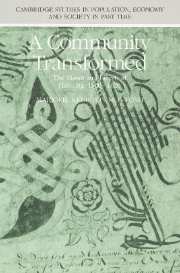Book contents
- Frontmatter
- Contents
- List of figures
- List of tables
- Acknowledgements
- Abbreviations
- Introduction
- 1 Life and death
- 2 Changing economic patterns
- 3 Religion
- 4 Facets of a society in transition
- 5 Havering's declining independence
- 6 Overt conflict, 1607–19
- Conclusion
- Appendices
- Bibliography
- Index
- Cambridge Studies in Population, Economy and Society in Past Time
Introduction
Published online by Cambridge University Press: 11 October 2009
- Frontmatter
- Contents
- List of figures
- List of tables
- Acknowledgements
- Abbreviations
- Introduction
- 1 Life and death
- 2 Changing economic patterns
- 3 Religion
- 4 Facets of a society in transition
- 5 Havering's declining independence
- 6 Overt conflict, 1607–19
- Conclusion
- Appendices
- Bibliography
- Index
- Cambridge Studies in Population, Economy and Society in Past Time
Summary
At no time during the later Middle Ages or early modern period was Havering-atte-Bower a typical English community. Although this royal manor and Liberty in Essex contained many features found in other places, new developments emerged here long before they became common elsewhere. Between 1200 and 1500, Havering's economic and political forms grew in a precocious fashion, marked by unusual personal freedom and widespread prosperity for the tenants, considerable co-operation among them in running their community, and exceptional independence from outside control. By the end of the fifteenth century, Havering displayed many patterns and attitudes which would be seen elsewhere in England during the decades around 1600.
The community continued to change between 1500 and 1620, a process to be traced in this study. Havering's medieval characteristics were transformed over the course of the sixteenth century by demographic forces and pressure from the economy, religion, social and cultural forms, and local administration and law. This restructuring had several main consequences. The shared outlook of the later medieval years was disrupted and the willingness to work together for common goals weakened. Economic power and influence over religion and local government, formerly distributed among more than a hundred families of yeomen, husbandmen, and craftsmen/traders, were by 1620 concentrated into the hands of just a few gentlemen and nobles with great landed estates.
- Type
- Chapter
- Information
- A Community TransformedThe Manor and Liberty of Havering-atte-Bower 1500–1620, pp. 1 - 7Publisher: Cambridge University PressPrint publication year: 1991

